Related Research Articles

Roger Williams was a Puritan minister, theologian, and author who founded Providence Plantations, which became the Colony of Rhode Island and later the U.S. state of Rhode Island. He was a staunch advocate for religious freedom, separation of church and state, and fair dealings with Native Americans.

Narragansett is a town in Washington County, Rhode Island, United States. The population was 15,868 at the 2010 census. However, during the summer months the town's population more than doubles to near 34,000. The town is colloquially known as "Gansett". The town of Narragansett occupies a narrow strip of land running along the eastern bank of the Pettaquamscutt River to the shore of Narragansett Bay. It was separated from South Kingstown in 1888, and incorporated as a town in 1901.

North Kingstown is a town in Washington County, Rhode Island, United States, and is part of the Providence metropolitan area. North Kingstown is home to the birthplace of American portraitist Gilbert Stuart, who was born in the village of Saunderstown. Within the town is Quonset Point, location of the former Naval Air Station Quonset Point, known for the invention of the Quonset hut, as well as the historic village of Wickford.
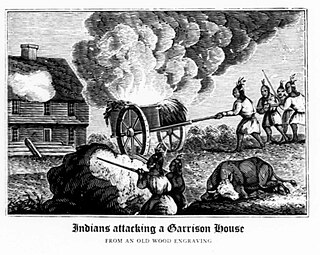
King Philip's War was an armed conflict in 1675–1678 between indigenous inhabitants of New England and New England colonists and their indigenous allies. The war is named for Metacom, the Wampanoag chief who adopted the name Philip because of the friendly relations between his father Massasoit and the Mayflower Pilgrims. The war continued in the most northern reaches of New England until the signing of the Treaty of Casco Bay in April 1678.
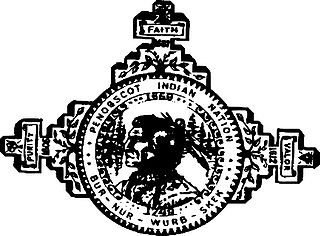
The Penobscot (Panawahpskek) are an Indigenous people in North America from the Northeastern Woodlands region. They are organized as a federally recognized tribe in Maine and as a First Nations band government in the Atlantic provinces and Quebec.

The Narragansett people are an Algonquian American Indian tribe from Rhode Island. The tribe was nearly landless for most of the 20th century, but it worked to gain federal recognition and attained it in 1983. It is officially the Narragansett Indian Tribe of Rhode Island and is made up of descendants of tribal members who were identified in an 1880 treaty with the state.

Samp is an African food consisting of dried corn kernels that have been pounded and chopped until broken, but not as finely ground as mealie-meal or mielie rice. The coating around the kernel loosens and is removed during the pounding and stamping process. It is eaten across South Africa and by the Lozi and Tonga people of Zambia with sugar and sour milk. It can also be served with gravy and various additives. It is cooked with beans in the Xhosa variant of umngqusho and sometimes eaten with chakalaka. It can also be served with beef, lamb, poultry and in stuffings.
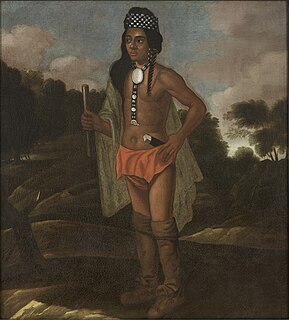
Ninigret was a sachem of the eastern Niantic Indian tribe in New England at the time of colonization, based in Rhode Island. In 1637, he allied with the colonists and the Narragansetts against the Pequot Indians.
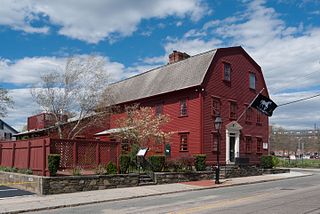
The history of Rhode Island is an overview of the Colony of Rhode Island and Providence Plantations and the state of Rhode Island from pre-colonial times to the present.
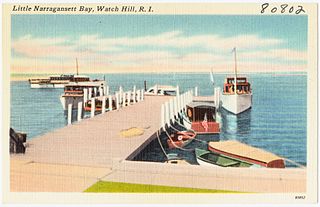
Little Narragansett Bay is an inlet of the Atlantic Ocean and an estuary of the Pawcatuck River on the Rhode Island-Connecticut state line. It is sheltered by a curving peninsula, known as Napatree Point.
Ellison Myers Brown, widely known as Tarzan Brown, a direct descendant of the last acknowledged royal family of the Narragansett Indian Tribe of Rhode Island, was a two-time winner of the Boston Marathon in 1936 (2:33:40) and 1939 (2:28:51) and 1936 U.S. Olympian. He ran the marathon in the 1936 Summer Olympics in Berlin and also qualified for the 1940 Summer Olympics, but these were ultimately canceled due to the outbreak of World War II.

Chepiwanoxet is a neighborhood in Warwick, Rhode Island, with an island peninsula in Greenwich Bay, an arm of Narragansett Bay. The neighborhood straddles the Amtrak railroad lines, which lies just east of and parallel to the Post Road. Its boundaries are Neptune Street to the North, Alger Avenue to the South, Post Road to the West, and Greenwich Bay to the East. Chepiwanoxet Way, an underpass beneath the Amtrak lines, now serves as the only street access in and out of the neighborhood.
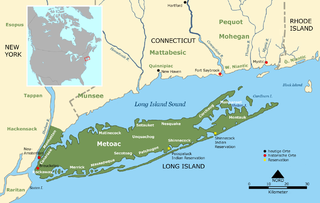
Metoac is a name used by some to describe the Munsee-speaking Lenape and Pequot Native Americans on what is now Long Island in New York state. The term, a geographic rather than political grouping, was adopted by amateur anthropologist and U.S. Congressman Silas Wood in the mistaken belief that the various bands on the island comprised distinct tribes.

Narragansett is an Algonquian language formerly spoken in most of what is today Rhode Island by the Narragansett people. It was closely related to the other Algonquian languages of southern New England like Massachusett and Mohegan-Pequot. The earliest study of the language in English was by Roger Williams, founder of the Rhode Island colony, in his book A Key Into the Language of America (1643).

The Narragansett land claim was one of the first litigations of aboriginal title in the United States in the wake of the U.S. Supreme Court's landmark Oneida Indian Nation of New York v. County of Oneida (1974), or Oneida I, decision. The Narragansett claimed a few thousand acres of land in and around Charlestown, Rhode Island, challenging a variety of early 19th century land transfers as violations of the Nonintercourse Act, suing both the state and private land owners.

The Narragansett Trail is a 16-mile (26 km) Connecticut hiking trail and is one of the Blue-Blazed hiking trails maintained by the Connecticut Forest and Park Association and the Narragansett Council, the Rhode Island chapter of the Boy Scouts of America.
The Narragansett Dawn was a monthly newspaper that discussed the history, culture and language of the Narragansett tribe. It was produced in 1935 and 1936 with a total of sixteen issues. The founders and editors of the paper were Princess Red Wing and Ernest Hazard. Both were Narragansett tribal members.
John Christian Hopkins is a Narragansett journalist, author, poet and public speaker who resides in Tuba City, Arizona, United States. After having grown up in Hope Valley, Rhode Island, Hopkins graduated from the University of Rhode Island with degrees in journalism and history in 1987.
The Wunnashowatuckoog, sometimes referred to as Showatucks, were a native American tribe in Massachusetts who lived in southern Worcester County, Massachusetts. The name of the tribe, translating to 'people at the fork of the river', alludes to them residing on the Blackstone River. They were known to cohabitate with the Monashackotoog.
References
- Donald Ricky (1 January 1998). Encyclopedia of New Jersey Indians: Encyclopedia of Native Peoples. Somerset Publishers, Inc. p. 192. ISBN 978-0-403-09331-1.